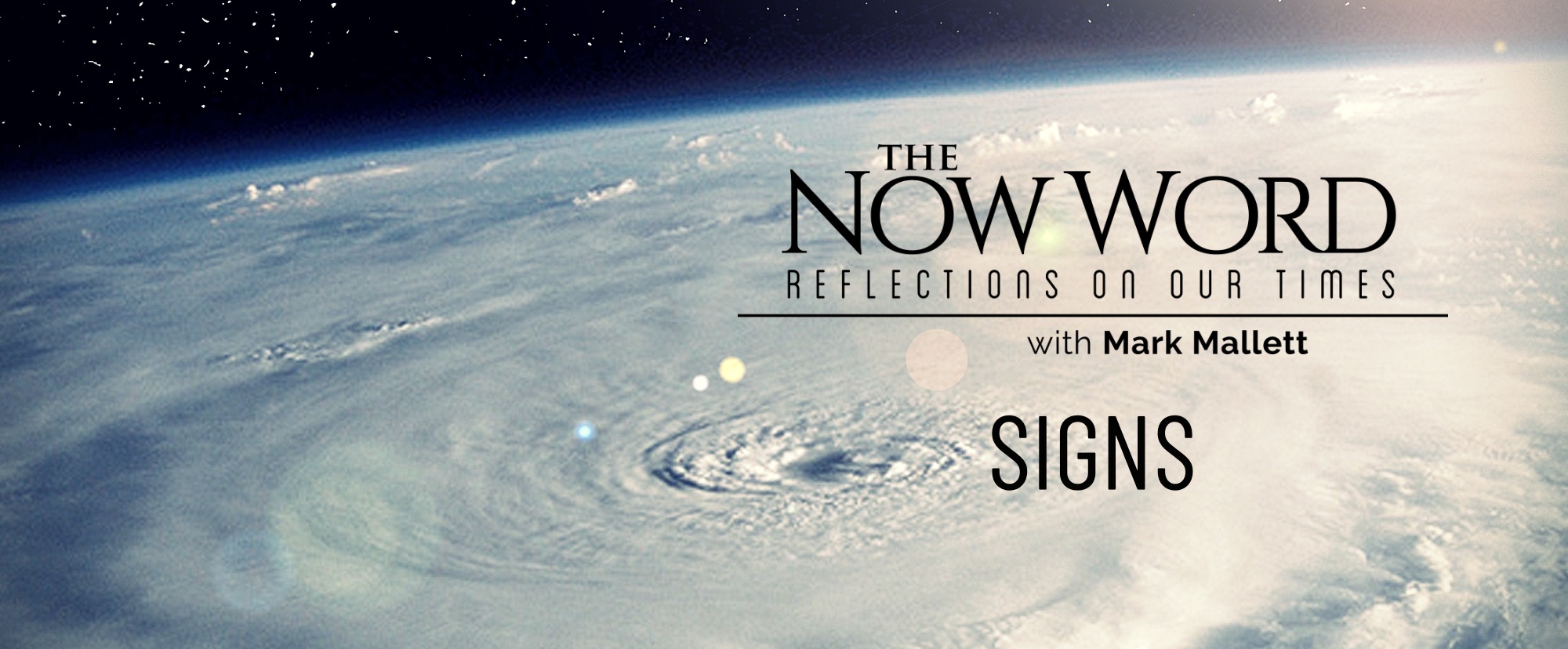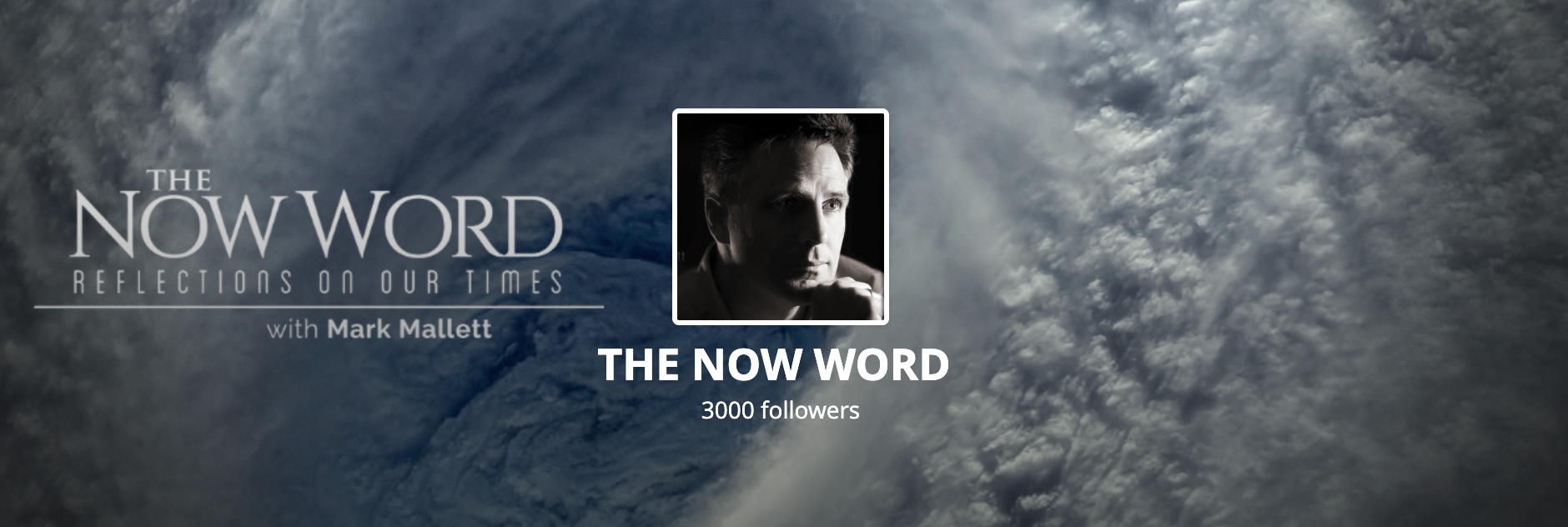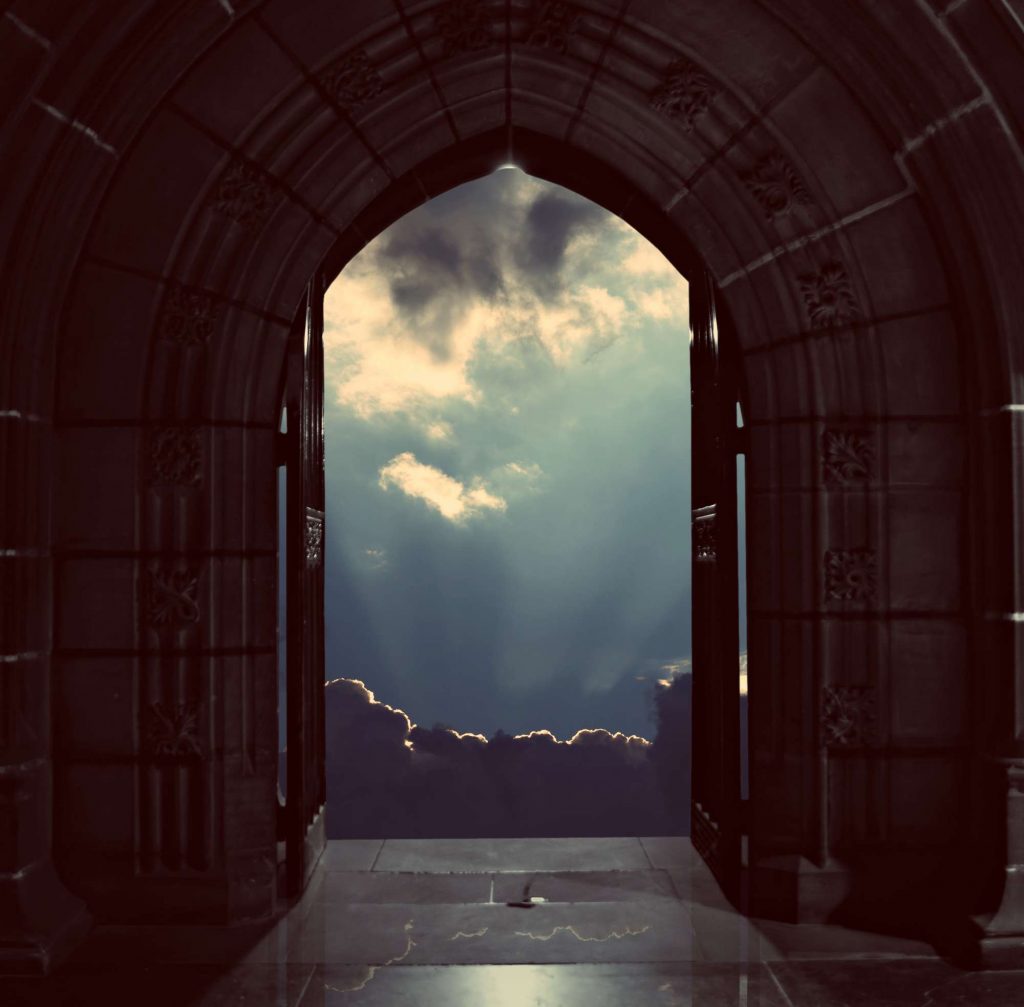
The most authoritative view, and the one that appears
to be most in harmony with Holy Scripture, is that,
after the fall of the Antichrist, the Catholic Church will
once again enter upon a period of
prosperity and triumph.
—The End of the Present World and the Mysteries of the Future Life,
Fr. Charles Arminjon (1824-1885), p. 56-57; Sophia Institute Press
THERE is a mysterious passage in the book of Daniel that is unfolding in our time. It further reveals what God is planning at this hour as the world continues its descent into darkness…
THE UNSEALING
After seeing in visions the rise of a “beast” or Antichrist, who would come toward the end of the world, the prophet is then told:
Go your way, Daniel, for the words are shut up and sealed until the time of the end. Many shall purify themselves, and make themselves white, and be refined… (Daniel 12:9-10)
The Latin text says these words will be sealed usque ad tempus praefinitum—“until a predetermined time.” The proximity of that time is revealed in the next sentence: when “many shall purify themselves, and make themselves white.” I’ll come back to this in a few moments.
Over the past century, the Holy Spirit has been revealing to the Church the fullness of the plan of Redemption through Our Lady, several mystics, and a recovery of the authentic meaning of the teachings of the Early Church Fathers on the Book of Revelation. Indeed, the Apocalypse is a direct echo of Daniel’s visions, and therefore, the “unsealing” of its contents presupposes a fuller understanding of its meaning in keeping with the “Public Revelation” of the Church—Sacred Tradition.
…even if [Public] Revelation is already complete, it has not been made completely explicit; it remains for Christian faith gradually to grasp its full significance over the course of the centuries.“ —Catechism of the Catholic Church, n. 66
As a sidenote, in the locutions to the late Fr. Stefano Gobbi whose writings bear two Imprimaturs, Our Lady allegedly confirms that the “Book” of Revelation has now been unsealed:
Mine is an apocalyptic message, because you are in the heart of that which has been announced to you in the last and so very important book of Sacred Scripture. I entrust to the angels of light of my Immaculate Heart the task of bringing you to an understanding of these events, now that I have opened the sealed Book for you. —To the Priests, Our Lady’s Beloved Sons, n. 520, i,j.
That which is being “unsealed” in our times is a deeper grasp of what St. John calls the “first resurrection” of the Church.[1]cf. Rev 20:1-6 And all of creation is awaiting it…
THE SEVENTH DAY
The prophet Hosea writes:
He will revive us after two days; on the third day he will raise us up, to live in his presence. (Hosea 6:2)
Again, recall the words of Pope Benedict XVI to journalists on his flight to Portugal in 2010, that there is 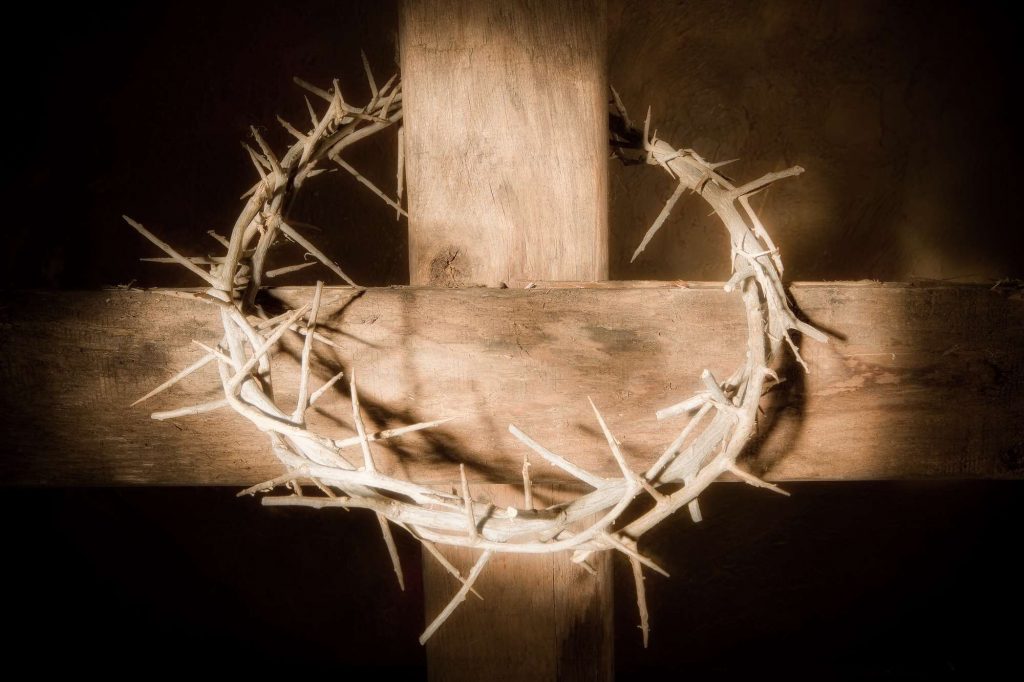 “the need for a passion of the Church.” He warned that many of us have fallen asleep at this hour, much like the Apostles in Gethsemane:
“the need for a passion of the Church.” He warned that many of us have fallen asleep at this hour, much like the Apostles in Gethsemane:
…‘the sleepiness’ is ours, of those of us who do not want to see the full force of evil and do not want to enter into his Passion.” —POPE BENEDICT XVI, Catholic News Agency, Vatican City, Apr 20, 2011, General Audience
For…
…[the Church] will follow her Lord in his death and Resurrection. —Catechism of the Catholic Church, 677
That being the case, the Church will also follow her Lord for “two days” in the tomb, and rise on the “third day.” Let me explain this through the teachings of the Early Church Fathers…
A DAY IS LIKE A THOUSAND YEARS
They viewed human history in light of the story of creation. God created the world in six days and, on the seventh, He rested. In this, they saw a fitting pattern to apply to the People of God.
And God rested on the seventh day from all his works… Therefore, a sabbath rest still remains for the people of God. (Heb 4:4, 9)
They saw human history, beginning with Adam and Eve until the time of Christ as essentially four thousand years, or “four days” based on St. Peter’s words:
Do not ignore this one fact, beloved, that with the Lord one day is like a thousand years and a thousand years like one day. (2 Peter 3:8)
The time from Christ’s Ascension to the threshold of the third millennium would be “two more days.” In that regard, there is a staggering prophecy unfolding right there. The Church Fathers foresaw that this present millennium would usher in the “seventh day”—a “sabbath rest” for the People of God (see The Coming Sabbath Rest) that would coincide with the death of the Antichrist (“the beast”) and the “first resurrection” spoken of in St. John’s 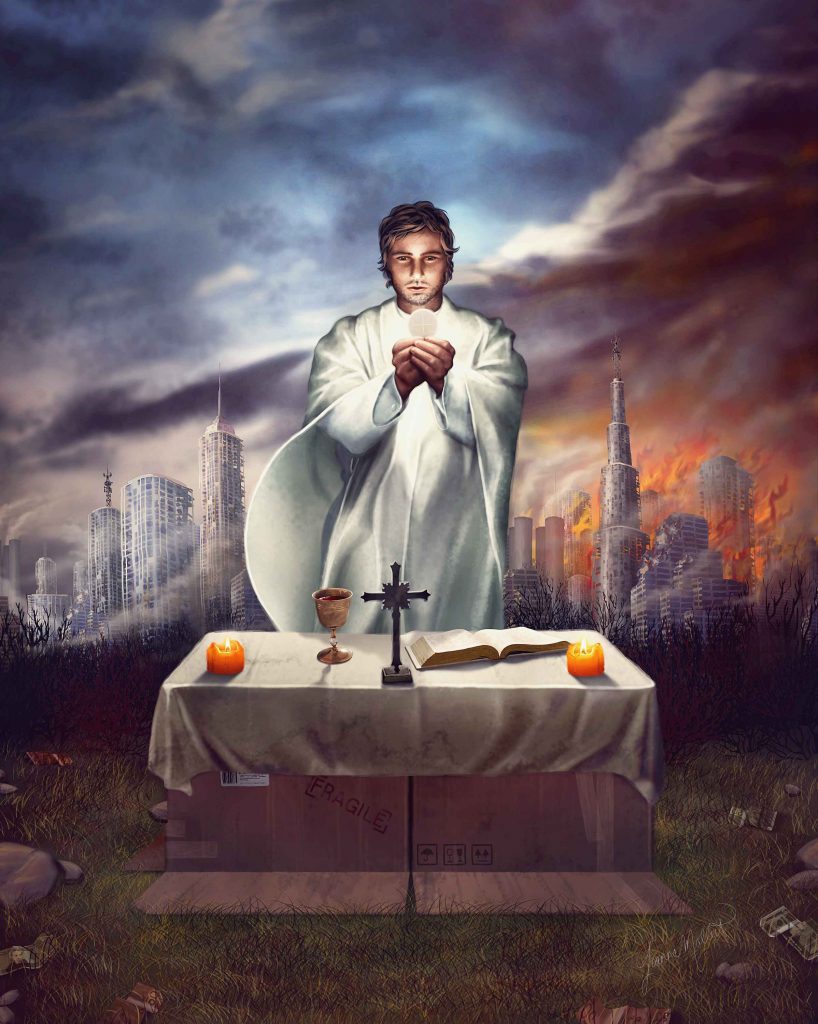 Apocalypse:
Apocalypse:
The beast was caught and with it the false prophet who had performed in its sight the signs by which he led astray those who had accepted the mark of the beast and those who had worshiped its image. The two were thrown alive into the fiery pool burning with sulfur… I also saw the souls of those who had been beheaded for their witness to Jesus and for the word of God, and who had not worshiped the beast or its image nor had accepted its mark on their foreheads or hands. They came to life and they reigned with Christ for a thousand years. The rest of the dead did not come to life until the thousand years were over. This is the first resurrection. Blessed and holy is the one who shares in the first resurrection. The second death has no power over these; they will be priests of God and of Christ, and they will reign with him for the thousand years. (Revelation 19:20-20:6)
As I explained in How the Era was Lost, St. Augustine proposed four explanations of this text. The one that has “stuck” with the majority of theologians to this day is that the “first resurrection” refers to the period after Christ’s Ascension until the end of human history. The problem is that this does not fit with the plain reading of the text, nor is it consonant with what the Early Church Fathers taught. However, Augustine’s other explanation of the “thousand years” does:
…as if it were a fit thing that the saints should thus enjoy a kind of Sabbath-rest during that period, a holy leisure after the labors of six thousand years since man was created… (and) there should follow on the completion of six thousand years, as of six days, a kind of seventh-day Sabbath in the succeeding thousand years… And this opinion would not be objectionable, if it were believed that the joys of the saints, in that Sabbath, shall be spiritual, and consequent on the presence of God… —St. Augustine of Hippo (354-430 A.D.; Church Doctor), De Civitate Dei, Bk. XX, Ch. 7, Catholic University of America Press
It is also the expectation of numerous popes:
I would like to renew to you the appeal I made to all the young people… accept the commitment to be morning watchmen at the dawn of the new millennium. This is a primary commitment, which keeps its validity and urgency as we begin this century with unfortunate dark clouds of violence and fear gathering on the horizon. Today, more than ever, we need people who live holy lives, watchmen who proclaim to the world a new dawn of hope, brotherhood and peace. —POPE ST. JOHN PAUL II, “Message of John Paul II to the Guannelli Youth Movement”, April 20th, 2002; vatican.va
…A new age in which hope liberates us from the shallowness, apathy, and self-absorption which deaden our souls and poison our relationships. Dear young friends, the Lord is asking you to be prophets of this new age… —POPE BENEDICT XVI, Homily, World Youth Day, Sydney, Australia, July 20th, 2008
John Paul II linked this “new millennium” to the “coming” of Christ: [2]cf. Is Jesus Really Coming? and Dear Holy Father… He is Coming!
Dear young people, it is up to you to be the watchmen of the morning who announce the coming of the sun who is the Risen Christ! —POPE JOHN PAUL II, Message of the Holy Father to the Youth of the World, XVII World Youth Day, n. 3; (cf. Is 21:11-12)
What the Church Fathers—up until our most recent popes—have been announcing, is not the end of the world, but an “era” or “period of peace,” a true “rest” whereby the nations would be pacified, Satan chained, and the Gospel extended to every coastland (see The Popes, and the Dawning Era). St. Louis de Montfort gives a perfect preamble to the Magisterium’s prophetic words:
Your divine commandments are broken, your Gospel is thrown aside, torrents of iniquity flood the whole earth carrying away even your servants. The whole land is desolate, ungodliness reigns supreme, your sanctuary is desecrated and the abomination of desolation has even contaminated the holy place. God of Justice, God of Vengeance, will you let everything, then, go the same way? Will everything come to the same end as Sodom and Gomorrah? Will you never break your silence? Will you tolerate all this for ever? Is it not true that your will must be done on earth as it is in heaven? Is it not true that your kingdom must come? Did you not give to some souls, dear to you, a vision of the future renewal of the Church? —St. Louis de Montfort, Prayer for Missionaries, n. 5; www.ewtn.com
It is God’s task to bring about this happy hour and to make it known to all… When it does arrive, it will turn out to be a solemn hour, one big with consequences not only for the restoration of the Kingdom of Christ, but for the pacification of… the world. We pray most fervently, and ask others likewise to pray for this much-desired pacification of society. —POPE PIUS XI, Ubi Arcani dei Consilioi “On the Peace of Christ in his Kingdom”, December 23, 1922
 Most significant is that this “happy hour” would also coincide with the perfection of the People of God. Scripture is clear that the sanctification of the Body of Christ is necessary in order to make her a fitting Bride for Christ’s return in glory:
Most significant is that this “happy hour” would also coincide with the perfection of the People of God. Scripture is clear that the sanctification of the Body of Christ is necessary in order to make her a fitting Bride for Christ’s return in glory:
…to present you holy, without blemish, and irreproachable before him… that he might present to himself the church in splendor, without spot or wrinkle or any such thing, that she might be holy and without blemish. (Col 1:22, Eph 5:27)
This preparation is precisely what St. John XXIII had at heart:
The task of humble Pope John is to “prepare for the Lord a perfect people,” which is exactly like the task of the Baptist, who is his patron and from whom he takes his name. And it is not possible to imagine a higher and more precious perfection than that of the triumph of Christian peace, which is peace at heart, peace in the social order, in life, in wellbeing, in mutual respect, and in the brotherhood of nations. —POPE ST. JOHN XXIII, True Christian Peace, December 23rd, 1959; www.catholicculture.org
Here is why the “millennium” is often referred to as an “era of peace”; the interior perfection of the Church has external consequences, namely, the temporal pacification of the world. But it is more than that: it is the restoration of the Kingdom of the Divine Will that Adam lost through sin. Hence, Pope Piux XII saw this coming restoration as a “resurrection” of the Church before the end of the world:
But even this night in the world shows clear signs of a dawn that will come, of a new day receiving the kiss of a new and more resplendent sun… A new resurrection of Jesus is necessary: a true resurrection, which admits no more lordship of death… In individuals, Christ must destroy the night of mortal sin with the dawn of grace regained. In families, the night of indifference and coolness must give way to the sun of love. In factories, in cities, in nations, in lands of misunderstanding and hatred the night must grow bright as the day, nox sicut dies illuminabitur, and strife will cease and there will be peace. —POPE PIUX XII, Urbi et Orbi address,March 2nd, 1957; vatican.va
Are you sensing a bit of hope right now? I hope so. Because the satanic kingdom rising at this present hour is not the final word on human history.
THE DAY OF THE LORD
This “resurrection,” according to St. John, inaugurates a “thousand year” reign—what the Church Fathers called “the day of the Lord.” It’s not a 24 hour day, but is represented symbolically by “one thousand.”
Behold, the Day of the Lord shall be a thousand years. —Letter of Barnabas, The Fathers of the Church, Ch. 15
Now… we understand that a period of one thousand years is indicated in symbolic language. —St. Justin Martyr, Dialogue with Trypho, Ch. 81, The Fathers of the Church, Christian Heritage
St. Thomas Aquinas affirms that this number should not be taken literally:
As Augustine says, the last age of the world corresponds to the last stage of a man’s life, which does not last for a fixed number of years as the other stages do, but lasts sometimes as long as the others together, and even longer. Wherefore the last age of the world cannot be assigned a fixed number of years or generations. —St. Thomas Aquinas, Quaestiones Disputate, Vol. II De Potentia, Q. 5, n.5; www.dhspriory.org
Unlike the millenarianists who erroneously believed that Christ would literally come to reign in the flesh on earth, the Church Fathers understood the Scriptures in the spiritual allegory in which they were written (see Millennarianism—What it is, and is Not). Theologian Rev. Joseph Iannuzzi’s work in differentiating the Church Fathers’ teachings from the heretical sects (Chiliasts, Montanists, etc.) has become the necessary theological groundwork in bridging the prophecies of the popes to not only the Church Fathers and the Scriptures, but also to the revelations imparted to 20th-century mystics. I would even say his work is helping to “unseal” that which has been reserved for the end times.
I sometimes read the Gospel passage of the end times and I attest that, at this time, some signs of this end are emerging. —POPE PAUL VI, The Secret Paul VI, Jean Guitton, p. 152-153, Reference (7), p. ix.
THE KINGDOM OF THE DIVINE WILL
Everything Jesus said and did was, in His words, not His own human will, but that of His Father’s.
Amen, amen, I say to you, a son cannot do anything on his own, but only what he sees his father doing; for what he does, his son will do also. For the Father loves his Son and shows him everything that he himself does… (John 5:19-20)
Here we have a perfect summary of why Jesus took upon Himself our humanity: to unite and restore our human will in the Divine. In a word, to divinize mankind. What Adam lost in the Garden was precisely that: 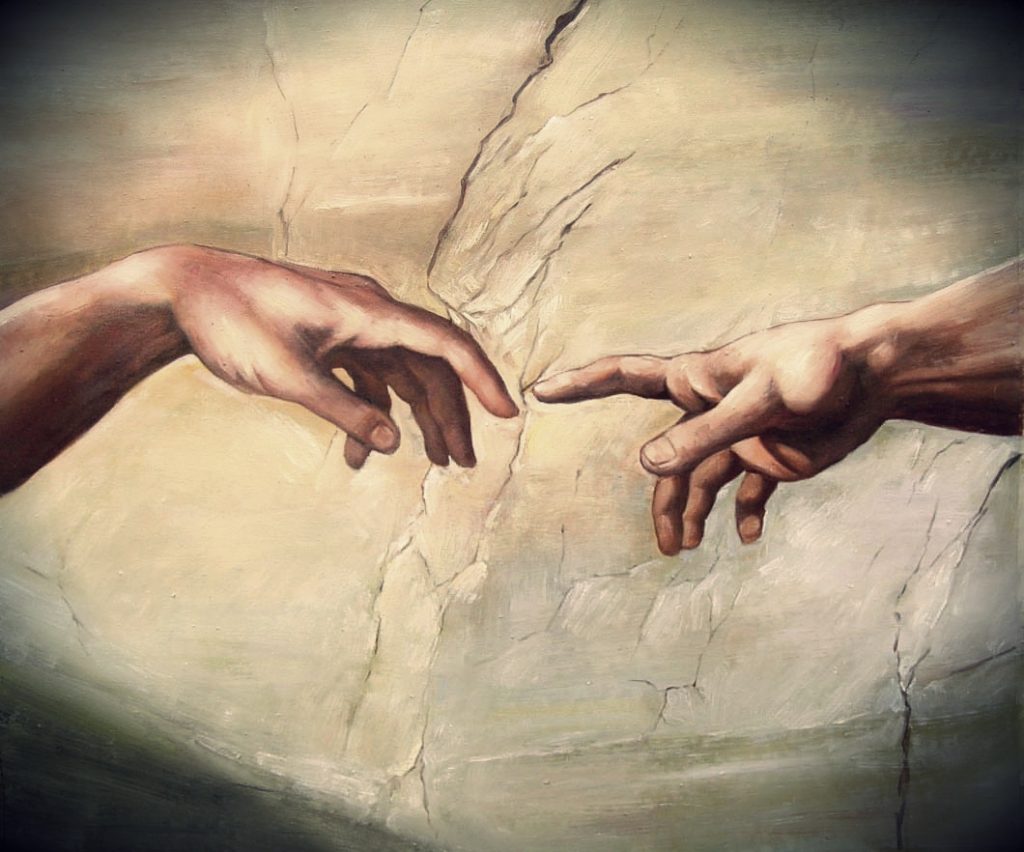 his union in the Divine Will. Jesus came to restore not only friendship with God but communion.
his union in the Divine Will. Jesus came to restore not only friendship with God but communion.
“All creation,” said St. Paul, “groans and labors up till now,” awaiting Christ’s redemptive efforts to restore the proper relationship between God and his creation. But Christ’s redemptive act did not of itself restore all things, it simply made the work of redemption possible, it began our redemption. Just as all men share in the disobedience of Adam, so all men must share in the obedience of Christ to the Father’s will. Redemption will be complete only when all men share his obedience… —Servant of God Fr. Walter Ciszek, He Leadeth Me (San Francisco: Ignatius Press, 1995), pp. 116-117
Thus, the “first resurrection” appears to be a restoration of what Adam and Eve forfeited in the Garden of Eden: a life lived in the Divine Will. This grace is far more than simply bringing the Church into a state of doing God’s will, but into a state of being, such that the Divine Will of the Holy Trinity becomes that also of the mystical Body of Christ.
For the mysteries of Jesus are not yet completely perfected and fulfilled. They are complete, indeed, in the person of Jesus, but not in us, who are his members, nor in the Church, which is his mystical body. —St. John Eudes, treatise “On the Kingdom of Jesus”, Liturgy of the Hours, Vol IV, p 559
Now is not the time to expand in detail what this “looks like”; Jesus did so in thirty-six volumes to Servant of God Luisa Piccarreta. Rather, let it suffice to simply say that God intends to restore in us “the gift of living in the Divine Will.” The impact of this will reverberate throughout the cosmos as the “final word” on human history before the consummation of all things.
The gift of Living in the Divine Will restores to the redeemed the gift that prelapsarian Adam possessed and that generated divine light, life and sanctity in creation… —Rev. Joseph Iannuzzi, The Gift of Living in the Divine Will in the Writings of Luisa Piccarreta (Kindle Locations 3180-3182); NB. This work bears the Vatican University’s seals of approval as well as ecclesiastical approval.
The Catechism of the Catholic Church teaches that “The universe was created ‘in a state of journeying’ (in statu viae) toward an ultimate perfection yet to be attained, to which God has destined it.” [3]Catechism of the Catholic Church, n. 302 That perfection is intrinsically linked to man, who is not only part of creation but its pinnacle. As Jesus revealed to Servant of God Luisa Piccaretta:
I desire, therefore, that My children enter My Humanity and copy what the Soul of My Humanity did in the Divine Will… Rising above every creature, they will restore the rights of Creation— My own as well as those of creatures. They will bring all things to the prime origin of Creation and to the purpose for which Creation came to be… —Rev. Joseph. Iannuzzi, The Splendor of Creation: The Triumph of the Divine Will on Earth and the Era of Peace in the Writings of the Church Fathers, Doctors and Mystics (Kindle Location 240)
Hence, says John Paul II:
The resurrection of the dead expected at the end of time already receives its first, decisive realization in spiritual resurrection, the primary objective of the work of salvation. It consists in the new life given by the risen Christ as the fruit of his redemptive work. —General Audience, April 22nd, 1998; vatican.va
This new life in Christ, according to the revelations to Luisa, will reach its pinnacle when the human will resurrects in the Divine Will.
Now, the portent of my Redemption was the Resurrection, which, more than refulgent Sun, crowned my Humanity, making even my most tiny acts shine, with such splendor and marvel as to astonish Heaven and earth. The Resurrection will be the beginning, the foundation and the fulfillment of all goods – crown and glory of all the Blessed. My Resurrection is the true Sun which worthily glorifies my Humanity; It is the Sun of the Catholic Religion; It is the glory of every Christian. Without Resurrection, it would have been as though heavens without Sun, without heat and without life. Now, my Resurrection is the symbol of the souls who will form their Sanctity in my Will. —Jesus to Luisa, April 15th, 1919, Vol. 12
RESURRECTION… A NEW HOLINESS
Since the Ascension of Christ two thousand years—or rather “two days” ago—one could say that the Church has gone down into the tomb with Christ awaiting her own resurrection—even if she still faces a definitive “Passion.”
For you have died, and your life is hidden with Christ in God. (Colossians 3:3)
And “all creation is groaning in labor pains even until now,” says St. Paul, as:
Creation awaits with eager expectation the revelation of the children of God… (Romans 8:19)
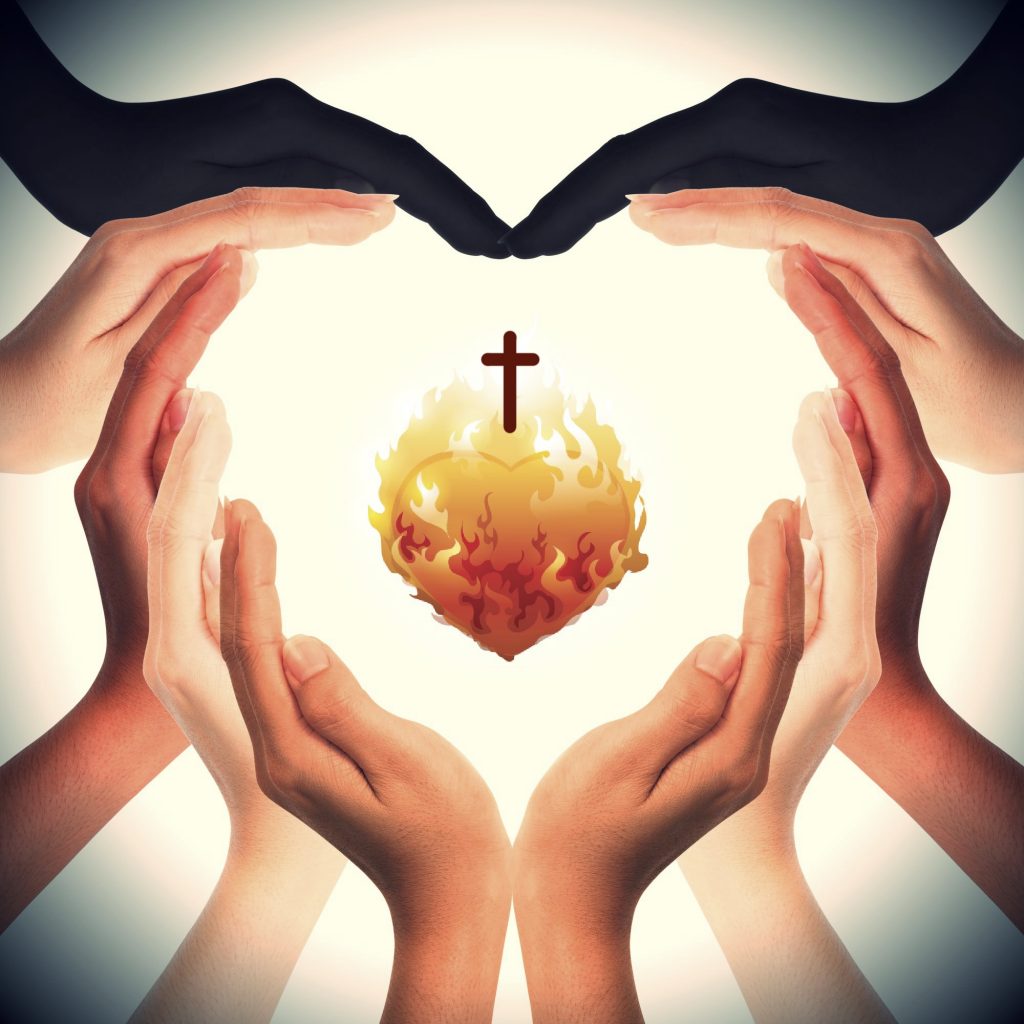 Note: Paul says that creation is awaiting, not the return of Jesus in the flesh, but the “revelation of the children of God.” The liberation of creation is intrinsically tied to the work of Redemption in us.
Note: Paul says that creation is awaiting, not the return of Jesus in the flesh, but the “revelation of the children of God.” The liberation of creation is intrinsically tied to the work of Redemption in us.
And we hear today the groaning as no one has ever heard it before… Pope [John Paul II] does indeed cherish a great expectation that the millennium of divisions will be followed by a millennium of unifications. —Cardinal Joseph Ratzinger (BENEDICT XVI), Salt of the Earth (San Francisco: Ignatius Press, 1997), translated by Adrian Walker
But this unity will only come about as a work of the Holy Spirit as through a “new Pentecost” when Jesus will reign in a new “mode” within His Church. The word “apocalypse” means “unveiling.” What is waiting to be unveiled, then, is the final stage of the Church’s journey: her purification and restoration in the Divine Will—exactly what Daniel wrote about thousands of years ago:
Many shall purify themselves, and make themselves white, and be refined… (Daniel 12:9-10)
…the wedding day of the Lamb has come, his bride has made herself ready. She was allowed to wear a bright, clean linen garment. (Revelation 19:7-8)
St. John Paul II explained that this will indeed be a special gift from on high:
God himself had provided to bring about that “new and divine” holiness with which the Holy Spirit wishes to enrich Christians at the dawn of the third millennium, in order to “make Christ the heart of the world.” —POPE JOHN PAUL II, Address to the Rogationist Fathers, n. 6, www.vatican.va
When Jesus reigns in His Church, such that the Divine Will reigns in her, this will bring to completion the “first resurrection” of the Body of Christ.
…the Kingdom of God means Christ himself, whom we daily desire to come, and whose coming we wish to be manifested quickly to us. For as he is our resurrection, since in him we rise, so he can also be understood as the Kingdom of God, for in him we shall reign. —Catechism of the Catholic Church, n. 2816
…they will be priests of God and of Christ, and they will reign with him for [the] thousand years. (Revelation 20:6)
Jesus says to Luisa:
…my Resurrection symbolizes the Saints of the living in my Will — and this with reason, since each act, word, step, etc. done in my Will is a Divine resurrection that the soul receives; it is a mark of glory that she receives; it is to go out of herself in order to enter the Divinity, and to love, work and think, hiding herself in the refulgent Sun of my Volition… —Jesus to Luisa, April 15th, 1919, Vol. 12
But, as Scripture and Tradition notes, the “day of the Lord” and the concomitant resurrection of the Church is first preceded by a great trial:
Thus even if the harmonious alignment of the stones should seem to be destroyed and fragmented and, as described in the twenty-first psalm, all the bones which go to make up Christ’s body should seem to be scattered by insidious attacks in persecutions or times of trouble, or by those who in days of persecution undermine the unity of the temple, nevertheless the temple will be rebuilt and the body will rise again on the third day, after the day of evil which threatens it and the day of consummation which follows. —St. Origen, Commentary on John, Liturgy of the Hours, Vol IV, p. 202
INTERIOR ONLY?
But is this “first resurrection” only spiritual and not bodily? The biblical text itself suggests that those who were “beheaded” and who had refused the mark of the beast “came to life and reigned with Christ.” However, this does not mean that they reign on earth. For example, immediately after Jesus died, the Gospel of Matthew attests that:
The earth quaked, rocks were split, tombs were opened, and the bodies of many saints who had fallen asleep were raised. And coming forth from their tombs after his resurrection, they entered the holy city and appeared to many. (Matt 27:51-53)
So here we have a concrete example of a bodily resurrection before the “resurrection of the dead” that comes at the very end of time (Rev 20:13). The Gospel account suggests that these risen Old Testament figures transcended time and space since they “appeared” to many (though the Church has not made any definitive pronouncement in this regard). This is all to say that there is no reason that a bodily resurrection is not possible whereby these martyrs will also “appear” to those on earth as many of the saints and Our Lady already have, and do. [4]see The Coming Resurrection However, generally speaking, Thomas Aquinas states of this first resurrection that…
…these words are to be understood otherwise, namely of the ‘spiritual’ resurrection, whereby men shall rise again from their sins to the gift of grace: while the second resurrection is of bodies. The reign of Christ denotes the Church wherein not only martyrs, but also the other elect reign, the part denoting the whole; or they reign with Christ in glory as regards all, special mention being made of the martyrs, because they especially reign after death who fought for the truth, even unto death. —Thomas Aquinas, Summa Theologica, Qu. 77, art. 1, rep. 4.; cited in The Splendor of Creation: The Triumph of the Divine Will on Earth and the Era of Peace in the Writings of the Church Fathers, Doctors and Mystics by Rev. Joseph Iannuzzi; (Kindle Location 1323)
However, it is primarily this interior sanctity that Piux XII prophesied — a sanctity that puts an end to mortal sin.
A new resurrection of Jesus is necessary: a true resurrection, which admits no more lordship of death… In individuals, Christ must destroy the night of mortal sin with the dawn of grace regained. —Urbi et Orbi address,March 2nd, 1957; vatican.va
Jesus says to Luisa that, indeed, this resurrection is not at the end of days but within time, when a soul begins to live in the Divine Will.
My daughter, in My Resurrection, souls received the rightful claims to rise again in Me to new life. It was the confirmation and seal of My entire life, of My works and of My words. If I came to earth it was to enable each and every soul to possess My Resurrection as their own – to give them life and make them resurrect in My own Resurrection. And do you wish to know when the real resurrection of the soul occurs? Not in the end of days, but while it is still alive on earth. One who lives in My Will resurrects to the light and says: ‘My night is over’… Therefore, the soul who lives in my Will can say, as the angel said to the holy women on the way to the sepulcher, ‘He is risen. He is not here anymore.’ Such a soul who lives in My Will can also say, ‘My will is no longer mine, for it has resurrected in God’s Fiat.’ —April 20, 1938, Vol. 36
Hence, says St. John, “Blessed and holy is the one who shares in the first resurrection. The second death has no power over these.” [5]Rev 20:6 They will be few in number — a “remnant” after the tribulations of the Antichrist.
Now, my Resurrection is the symbol of the souls who will form their Sanctity in my Will. The Saints of the past centuries symbolize my Humanity. Although resigned, they did not have continuous act in my Will; therefore, they did not receive the mark of the Sun of my Resurrection, but the mark of the works of my Humanity before my Resurrection. Therefore, they will be many; almost like stars, they will form a beautiful ornament to the Heaven of my Humanity. But the Saints of the living in my Will, who will symbolize my Resurrected Humanity, will be few. —Jesus to Luisa, April 15th, 1919, Vol. 12
Hence, the “triumph” of the end times is not merely the chaining of Satan in the abyss (Rev 20:1-3); rather, it is the restoration of the rights of sonship that Adam forfeited — that “died” as it were in the Garden of Eden — but which is being restored in the People of God in these “end times” as the final fruit of Christ’s Resurrection.
With this triumphant act, Jesus sealed the reality that He was [in his one divine Person both] Man and God, and with his Resurrection He confirmed his doctrine, his miracles, the life of the Sacraments and the entire life of the Church. Moreover, He obtained the triumph over the human will of all souls that are weakened and almost dead to any true good, so that the life of the Divine Will that was to bring the fullness of holiness and all blessings to souls should triumph over them. —Our Lady to Luisa, The Virgin in the Kingdom of the Divine Will, Day 28
..for the sake of the Resurrection of your Son, make me rise again in the Will of God. —Luisa to Our Lady, Ibid.
[I] implore the resurrection of the Divine Will within the human will; may we all resurrect in You… —Luisa to Jesus, 23rd Round in the Divine Will
It is this which brings the Body of Christ into her full maturity:
…until we all attain to the unity of faith and knowledge of the Son of God, to mature manhood, to the extent of the full stature of Christ… (Eph 4:13)
BECOMING OUR PERFECT SELVES
Clearly, St. John and the Church Fathers do not propose an “eschatology of despair” where Satan and Antichrist triumph until Jesus returns to put an end to human history. Sadly, some prominent Catholic eschatologists as well as Protestants are saying just that. The reason is that they are neglecting The Marian Dimension of the Storm that is already here and coming. For Holy Mary is…
…the image of the Church to come… —POPE BENEDICT XVI, Spe Salvi, n.50
And,
At once virgin and mother, Mary is the symbol and the most perfect realization of the Church… —Catechism of the Catholic Church, n. 507
Rather, what we are realizing anew is what the Church has taught from the beginning—that Christ will manifest His power within history, such that the Day of the Lord will bring about peace and justice in the world. It will be a resurrection of lost grace and a “sabbath rest” for the saints. What a witness this will be to the nations! As Our Lord Himself said: “This gospel of the kingdom will be preached throughout the world as a witness to  all nations, and then the end will come.” [6]Matthew 24:14 Using the allegorical language of the Old Testament prophets, the Early Church Fathers merely said the same thing:
all nations, and then the end will come.” [6]Matthew 24:14 Using the allegorical language of the Old Testament prophets, the Early Church Fathers merely said the same thing:
So, the blessing foretold undoubtedly refers to the time of His Kingdom, when the just will rule on rising from the dead; when creation, reborn and freed from bondage, will yield an abundance of foods of all kinds from the heaven’s dew and the fertility of the earth, just as the seniors recall. Those who saw John, the Lord’s disciple, [tell us] that they heard from him how the Lord taught and spoke about these times… —St. Irenaeus of Lyons, Church Father (140–202 A.D.); Adversus Haereses, Irenaeus of Lyons, V.33.3.4,The Fathers of the Church, CIMA Publishing
…His Son will come and destroy the time of the lawless one and judge the godless, and change the sun and the moon and the stars—then He shall indeed rest on the seventh day… after giving rest to all things, I will make the beginning of the eighth day, that is, the beginning of another world. —Letter of Barnabas (70-79 A.D.), written by a second century Apostolic Father
First published March 15th, 2018.
In Memory of
ANTHONY MULLEN (1956-2018)
who is being laid to rest today.
Until we meet again, dear brother…
Listen on the following:
Follow Mark and the daily “signs of the times” here:
To journey with Mark in The Now Word,
click on the banner below to subscribe.
Your email will not be shared with anyone.
Footnotes
| ↑1 | cf. Rev 20:1-6 |
|---|---|
| ↑2 | cf. Is Jesus Really Coming? and Dear Holy Father… He is Coming! |
| ↑3 | Catechism of the Catholic Church, n. 302 |
| ↑4 | see The Coming Resurrection |
| ↑5 | Rev 20:6 |
| ↑6 | Matthew 24:14 |

